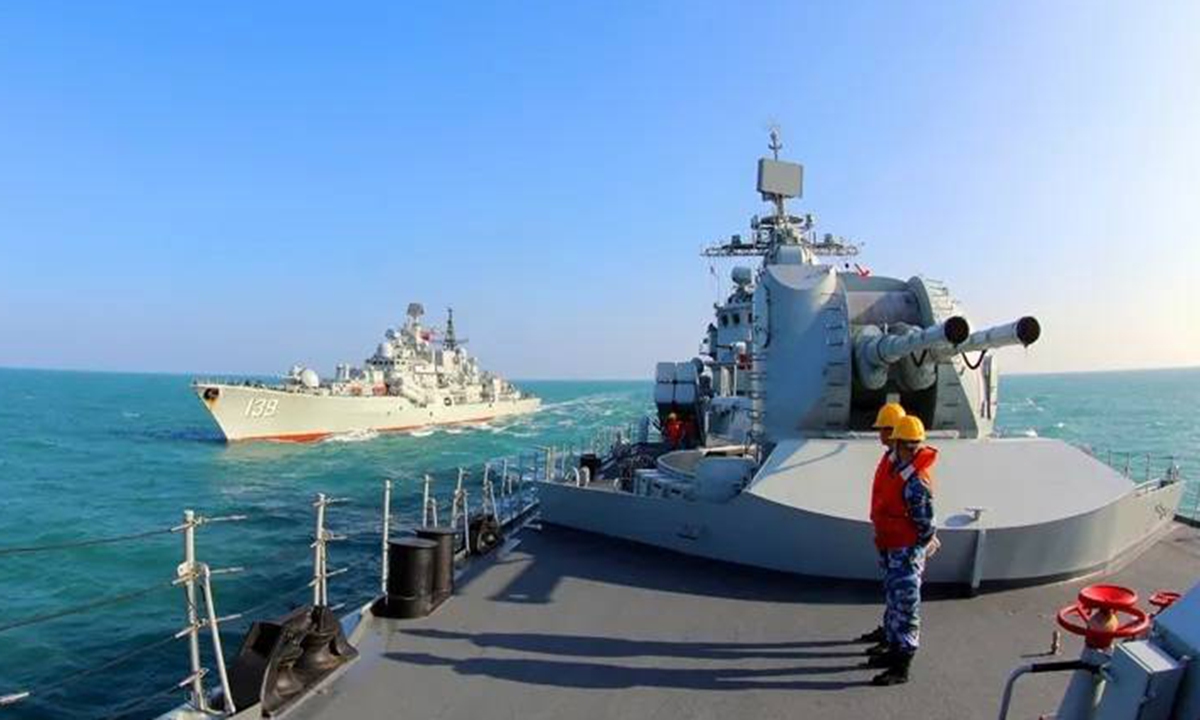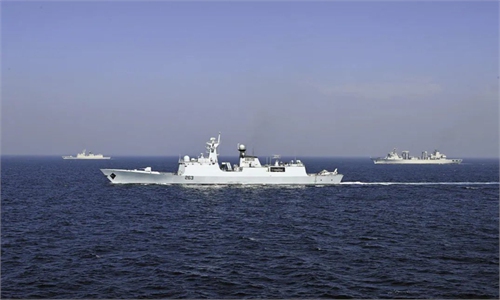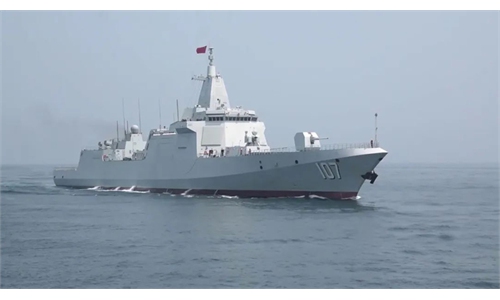Experts refute Australian charge claiming PLA destroyer's use of sonar 'unprofessional,' question Australian frigate's location, purpose in incident

Sovremenny-class guided missile destroyer Hangzhou (Hull 136) and Ningbo (Hull 139) attached to the PLA Eastern Theater Command Navy conduct exercises in early 2021. Photo: Screenshot from navy.81.cn
Chinese experts on Sunday refuted accusations from Australia claiming that a Chinese People's Liberation Army (PLA) destroyer used sonar to force divers from an Australian frigate to exit the water, saying that the Australian statement is vague and one-sided, and aims to hype the "China threat" theory.
The HMAS Toowoomba, an Anzac-class frigate of the Royal Australian Navy, on Tuesday sailed in "international waters inside of Japan's Exclusive Economic Zone" en route to commence a scheduled port visit during "operations in support of United Nations sanctions enforcement in the region" when it stopped to conduct diving operations in order to clear fishing nets that had become entangled around its propellers, the Australian defense department said in a press release on Saturday.
While diving operations were underway, a PLA Navy destroyer, the Sovremenny-class guided missile destroyer Ningbo (Hull 139), operating in the vicinity closed toward the HMAS Toowoomba, the Australian press release said.
According to the Australian press release, the two countries' vessels were able to establish communications, before the Australian ship detected the Chinese ship operating its hull-mounted sonar "in a manner that posed a risk to the safety of the Australian divers who were forced to exit the water."
The Australian press release is widely questioned by Chinese military experts, especially about the vague location given where the incident is supposed to have taken place.
Zhang Junshe, a Chinese naval expert, told the Global Times on Sunday that while Australia claimed the incident happened in Japan's exclusive economic zone, it did not give the exact location.
If the incident took place in waters to the west of Japan, China and Japan have not carried out maritime delimitation in relevant waters, so Japan's self-proclaimed exclusive economic zone could be well within waters administered by China, Zhang said.
Another Chinese military expert who requested anonymity told the Global Times on Sunday that Australia likely intentionally chose not to disclose the exact location because it has a guilty conscience.
"Did the incident take place near China's Diaoyu Islands or the island of Taiwan? Or was it close to a PLA training exercise? If that is the case, it was obvious that the Australian warship provoked China in the first place," the expert said.
Analysts pointed out that the Australian press release is one-sided as it failed to mention the Chinese input during the communications between the two countries' ships.
Since the Australian side admitted that it had established communications with the Chinese side, it is very likely that the Chinese ship issued verbal warnings which the Australian ship had ignored, and the Chinese ship was forced to take the ensuing step which was to send a warning through sonar, the abovementioned anonymous expert said.
Some of the main purposes of a sonar system is to detect submarines and underwater terrains, similar to how a radar system is used to detect aircraft, the expert said, explaining that active sonar generates sound waves that vibrate underwater.
Pinging with sonar is also a means to communicate, and in this case, was likely used to warn the Australian operation, the expert said.
Australia claimed that the sonar pulses likely caused minor injuries to the Australian divers, but the wording is also very vague and has no proof, analysts said.
"Australia said it had fishing nets that had become entangled around its frigate's propellers. It shows that such a close-in reconnaissance attempt not only posed threats to China's national security, but also to the normal maritime work of fishing boats," Zhang said.
In the recent period, countries like Australia and Canada have been repeatedly accusing Chinese warships and warplanes of "unsafe, unprofessional" interactions, as these forces from outside of the region conducted close-in reconnaissance operations on China's doorstep in the name of UN sanctions enforcement, observers said.
Alert patrols by Chinese warplanes and warships on China's doorstep are normal and should not have been hyped as "China threat," Zhang said.
These countries should stop sending warships and warplanes from thousands of kilometers away to stir up troubles and flex their muscles on China's doorstep, experts said.




